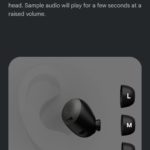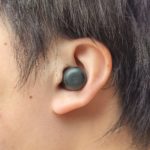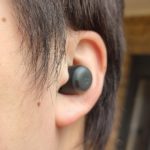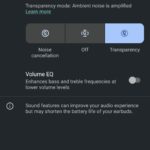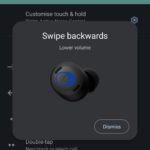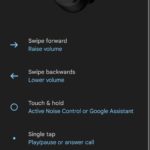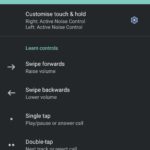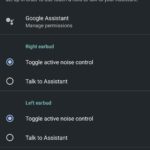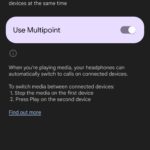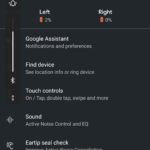Since Google released the first generation of Pixel Buds in 2017, the Pixel line has received two iterations, including the mid-range A-series launched last year. In July 2022, Google released Pixel Buds Pro as the latest addition to the production line. For $299, I was intrigued by what it offers to the consumer with this price tag.
Now that the Pixel adds “Pro” to the name this time around, which naturally raises my expectations. Among the in-ear devices I have used, Apple’s AirPods Pro is the one with an excellent overall performance at a slightly higher price. Therefore, in this review, I will use the AirPods Pro as a benchmark to compare the aspects of comfortability, ANC performance, sound quality, etc. It is worth noting that the latter has a full $100 higher MSRP.
Let’s start with the tech specs
Pixel Buds Pro has three colours available to choose from – Fog, Charcoal and Lemongrass. Each earbud weighs 6.2 grams (with medium ear tip) and 50 grams for the charging case. The case can be charged via a USB-C port, and yes, Pixel Buds Pro supports Qi-certified wireless charging. A 5-minute quick charge delivers up to an hour of listening time (with ANC on). Active Noise Cancellation can be switched between ‘Noise Cancellation’ and ‘Transparency’. The former is just self-explanatory, and the latter would amplify the ambient noise so you can hear the world around you. The earbuds can be used continuously for up to 11 hours without ANC or up to 7 hours with ANC with a fully charged battery. These are IPX4-rated for resistance to water splashes from any direction, and they can pair with Android, iOS and any operating system that has Bluetooth 4.0+ enabled.
Comfort and fit
At first, I was a little apprehensive about how well it would fit in the ear. I’ve tried many different in-ears in the past, many of which adopt a similar design to the Pixel Buds Pro. I’m reluctant to say this, but it’s hard to find any in-ears I’ve worn so far that provide the same level of comfort as the AirPods Pro.
To my surprise, the latest iteration of the Pixel Buds shatters my past beliefs about this type of design. When I tried to wear it with an uncertain mentality, this pair of earbuds went smoothly without the feeling of falling out as if they were not plugged in tightly. Maybe it’s my luck that the factory-equipped ear tips fit my ears just right. If you feel uncomfortable wearing it for the first time, try changing eartips of different sizes for the best fit for your ears.
To find out if prolonged wear would negatively affect comfort, I used it non-stop for over 7 hours on a leisurely weekend, and I hardly felt any discomfort from the earbuds. Usually, I would start to feel a bit of hurting after wearing the earbuds for 2 hours on those in-ears with a similar ‘bud-shaped’ design; however, I did not experience this discomfort with Pixel Buds Pro.
Microphones
Google puts much effort such as the adoption of beamforming, three microphones on each earbud, a voice accelerometer, and wind-blocking mesh, to bring us an insane result for call quality. When I say ‘insane’, I mean it. To test the mics, I made a phone call to a friend who was 20 metres away from me; we both were outdoors and it was very windy. I asked the mate to use the Pixel Buds Pro and I was on the phone’s built-in mic during the call. He could hear the strong wind in the background and had to concentrate during the conversation, while I felt exactly the opposite – his voice was clear, and I only heard a little breeze. This is the best result among the Bluetooth earphones I have ever tested.
Sound quality
They may not appear to be a great option for audiophiles, but the earbuds perform really well for everyday music listening. Pixel Buds Pro delivers quite an impressive bass and treble. However, I didn’t find the mid to be terrific. Of course, we are talking about the sound profile out-of-box. You can always tweak the EQ and make it sound more adapted to your taste when listening to music. Sadly, these earbuds only support SBC and AAC codecs. Although there is no big difference between AAC and aptX in terms of sound quality, the performance of aptX in latency is usually more satisfactory than that of AAC. For me, the number of codecs supported isn’t going to be a deciding factor in buying, but adding support for aptX or aptX HD is not too much of a requirement for a pair of earbuds that costs $299, I suppose?
Active noise cancellation
On public transport, when I turn on active noise cancellation and adjust the volume to between 50-60%, I could barely hear the noise from the outside. In my opinion, this noise reduction is excellent. For headphones, the biggest advantage of noise cancellation is that with this feature, users do not need to turn up the volume when listening to music in a noisy environment, which is considered to be good protection for ears. And in this regard, the Pixel Buds Pro has done its job quite well.
In terms of ANC performance alone (no music playing), the Pixel Buds Pro and AirPods Pro performed so closely that it was almost impossible to tell which one is better. If I had to quantify the difference, I’d say 8 out of 10 for the AirPods Pro and 7.5 out of 10 for the Pixel Buds Pro. Both earphones find a very good balance between comfort and noise cancellation.
Controls and Software
Compared to the AirPods Pro, the Pixel Buds Pro offers more options in terms of control, such as volume adjustment without going through your phone or voice assistant. This is actually one of my favourite features on the Buds Pro, and the volume adjustment is so responsive that I barely notice any lag. When you need to increase volume, just swipe your finger from back to front on the Buds Pro, and do the same in the opposite direction to lower the volume. This can be achieved with either left or right earbud, whichever you like.
To get the most out of Pixel Buds Pro, you will need an Android mobile to use the companion app named ‘Pixel Buds’, which can be downloaded from the Google Play Store. This is the only way to customise the touch & hold behaviour based on your preferences. The Pixel Buds app provides a range of functions to ensure a complete user experience for the product. For instance, the earbuds’ firmware gets updated through the app; you can also use the app to check the eartip seal and find the best fit for your ears. There is a function called ‘Volume EQ’, but don’t get confused with the equaliser that we use to change sound profiles.
Instead, what it does is enhance the performance of bass and treble at low volume levels. It does make a noticeable difference when turned on, but I kept it off most of the time since it doesn’t fit my listening habit and consumes more power.
Multipoint
Pixel Buds Pro supports multipoint and auto switching. Multipoint lets the earbuds keep connected to two audio sources at the same time, while audio switching works with supported sources that are connected to the same Google account. Although it’s not necessary, turning on both functions would make switching slightly faster according to Google. You will need to manually pause whatever is playing on one device before it switches over to another unless it’s an incoming phone call that has the highest priority in the system. However, if the switch-over is triggered by accident and you want it to connect back to the previous device, on Android there will be a notification banner that gives you the option to do so. The usefulness of multipoint varies on the type of device it connects to. I attempted to share Pixel Buds Pro between OPPO Find X2 Pro (smartphone with Android 12) and Nintendo Switch (non-smartphone). The earbuds did not connect to the Nintendo Switch automatically after pausing the music on my smartphone, and I had to manually connect the Pixel Buds Pro in the settings on this handheld gaming console. Switching from the gaming console to the smartphone is relatively easier. Turning off the gaming console’s screen sets the earbuds to an idle state and is instantly picked up by the smartphone.
Battery life and charging
The Pixel Buds Pro has an amazing performance on battery life. Google advertises 11 hours of playing time without ANC and 7 hours of playing time with ANC. I kept the active noise cancellation on all the time during the use, and the batteries depleted after 6 hours and 37mins of continuous listening time after a full charge. In comparison, I was never able to get it past 4 hours when using the AirPods Pro with ANC on. In my testing, the case battery dropped from 100% to 41% after fully charging the earbuds. I am not too sure how the measuring condition was set up in the lab, but it doesn’t seem to be able to last up to 20 hours of total listening time with the charging case in my use case scenario. However, this does not really bother me at all. It’s going to be very rare for me to use up all the batteries in the charging case if it’s not for review purposes.
Should you buy the Pixel Buds Pro?
Among the earbuds that I have used so far, Pixel Buds Pro is one of the few that does well in almost all aspects, including sound quality, mic performance, active noise cancelling and battery life. In most cases, you can get a good ANC from one pair of earbuds and different earbuds for decent battery life, or clear communication, it’s always one or another. From this perspective, this latest addition from Google covers them very well, I will call it an all-rounder.
It may not always be true but “You get what you pay for” actually does apply to Pixel Buds Pro. $299 is not a cheap price for a pair of earphones, but what I have experienced with the Buds Pro makes me think it’s worth the money.
If you use an Android phone and care about the call quality, ANC, and battery life of earphones, congratulations, the Pixel Buds Pro is pretty much just for you. After two weeks of experience, I am impressed by the excellent quality of voice calls and the lengthy battery life. Through the use of the Pixel Buds app, you will be able to explore everything Google has put into the product. However, for iPhone users, staying in Apple’s ecosystem may be a better idea since the Buds Pro does not automatically switch between iOS devices as AirPods would do. In addition, you will need an Android phone to use the app for firmware updates and customisation if you decide to try the Pixel Buds Pro as an iOS user.
Pros
- Comfortable to wear
- Multipoint and auto switching
- Excellent microphones
- Stunning battery life
Cons
- SBC and AAC codecs only, no aptX
- Water resistant only IPX2 for the case
- App only available on Android phones
- Missing feature ‘Attention Alerts’
Disclosure Statement
Due to hygiene, the unit is not being requested for return.






